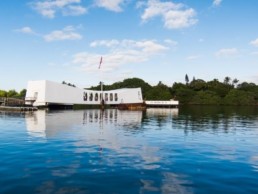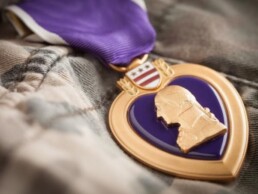“A Date Which Will Live In Infamy”: Remembering Pearl Harbor
December 7th marks the 75th anniversary of the attacks on Pearl Harbor. The two hour sneak attack by the Japanese left nearly 20 American naval vessels and more than 300 airplanes destroyed. Over 2,000 lives were lost and another 1,000 American soldiers and sailors were left injured. Three days later, after Congress approved President Franklin D. Roosevelt’s request to wage war on Japan, the United States joined other nations in World War II.
Much has changed for America since that day, but the feelings that survivors have about that day have not changed. Earl Brandes, Ed Guthrie, and Lawrence Osterbuhr were stationed in Honolulu the day Pearl Harbor was attacked. Now, 75 years later, all three men are back in their home state of Nebraska–Brandes is 95, Guthrie is 97, and Osterbuhr is 96.
“We’re really comrades,” Brandes said. “There’s not too many people left our age.” The three men used to be part of the Pearl Harbor Survivors Association, Nebraska chapter, but the group disbanded after December 2011 after the national organization decided there were too few members around to warrant a group. Since the group’s disbandment, the Sons and Daughters of Pearl Harbor Survivors, a group started in 1958, has helped to preserve the memory of those who served during the attack. “The Sons & Daughters wanted to make sure nobody forgot about Pearl Harbor,” Peg Murphy, Ed Guthrie’s daughter and the leader of the Nebraska chapter of the Sons & Daughters said.
Donald Stratton, another Pearl Harbor survivor from Red Cloud, Nebraska remembered the attack when he was a Seaman 1st Class aboard the USS Arizona. He and 1,177 shipmates managed to escape the Arizona for a neighboring ship and were spared during the attack. Stratton is now 94 years old, residing in Colorado Springs.
“The morning of Dec. 7, 1941, seemed like any other. We worked out a little bit and ate chow. I grabbed a few oranges to bring to a buddy of mine who was in the sick bay. Then I walked out onto the deck and saw some sailors congregating on the ship’s starboard side. They were looking across the water at Ford Island, an islet in the center of Pearl Harbor, and they were hollering — planes with the Japanese Zero insignia were banking through the sky.‘Oh, hell, it’s the Japanese!’ somebody shouted. ‘They’re bombing the water tower on Ford Island.’ We watched the tower fall and planes on the runway over there burst into flames,” Stratton said.
Across the nation, December 7th is a national day of remembrance. In El Paso, Colorado, Jim Downing was made a member of the El Paso County Commissioners just as a commemoration announcement for Pearl Harbor Day was announced. “My message to this generation: You are the leaders, you are the taxpayers, you are the voters, you are the legislators. Weakness invites aggression; keep America strong,” Downing said. “I want to keep America so strong that no adversary will ever think of attacking us.” Downing is one of the oldest living survivors at 103 years old.
In Hawaii, the war memorials for the attack are alive and thriving. This December 7th, people from all backgrounds will stand on Kilo Pier with the USS Arizona Memorial behind them to remember what happened. At the memorial, visitors can see pieces of metal from the downed ship in the water. The metal is still wet with oil that continuously leaks from the ship 75 years later. In addition, Hangar 79 at the Pacific Aviation Museum holds artifacts recovered from the site.
December 7, 1941 was a day of great loss for our country. It entered us into a war and the pain of the attack is still felt by survivors today. Now, we remember those who lost their lives in service to our country and try to keep their memory alive.
On December 7th, and every day, we remember the great sacrifice our soldiers and sailors made. The Purple Heart Foundation is committed to assisting veterans in all aspects of their lives, including helping those who are in need of assistance while transitioning home from the battlefield. You can show your support for these brave men and women who have sacrificed so much for our country by making a one-time or monthly pledge to ensure veterans continue to get the support and benefits they deserve by clicking here.
Mesothelioma Awareness Day: How This Disease Continues to Impact Veterans
Every 26th of September, Mesothelioma Awareness Day (MAD) is recognized as a day to spread information about this rare disease and educate people about the dangers of its only known cause, asbestos exposure. Of the nearly 3,000 Americans diagnosed with mesothelioma each year, 30 percent of this total are veterans. It is important that we acknowledge the veteran population affected by this disease and continue efforts towards finding a cure.
What is Mesothelioma?
Mesothelioma is a form of cancer that primarily affects the lining of the lungs, but can also be present in the lining of the abdomen and heart. Due to its prolonged latency period, symptoms of this disease typically do not arise for nearly 10 to 50 years. When symptoms do begin to appear, oftentimes, the disease has already progressed to an advanced stage, making treatment options extremely limited.
Historically, the cause of mesothelioma cancer has been linked to asbestos exposure. Asbestos is a naturally occurring mineral that was often used in materials prone to heat and friction. When asbestos is disturbed, airborne fibers have the ability to be inhaled or ingested, gaining access to our internal organs. These fibers lay dormant within our bodies where they cause inflammation and scarring, leading to the development of tumors.
For those diagnosed with mesothelioma, the prognosis is most often very poor. Patients who are diagnosed at an earlier stage are given between 16 to 21 months to live post-diagnosis, which is a limited amount of time to pursue treatment.
How Are Veterans Affected?
Service men and women of our military are susceptible to asbestos exposure as a result of mass historic use of asbestos-products. While there has been a decline in asbestos usage and stricter regulations, asbestos may still be present on military bases, naval ships, and aircraft equipment. Because of this, there is a steady diagnosis rate amongst veterans. This will remain unchanged until asbestos is completely banned in the United States or the government issues a mandate for all asbestos to be removed from military locations.
Those who have served our country between 1920 to 1980 are at the highest risk of developing an asbestos-related disease, as this was the height of asbestos usage. Locations such as the sleeping barracks of ships used in the Navy were tight and limited, allowing for a high concentration of fibers to be present if asbestos was disturbed. Other branches that are affected by asbestos include the Air Force, Army, Coast Guard and Marines through asbestos materials used in things such as aircraft braking systems, military vehicles, and fireproofing for ships.
An additional risk factor that should be kept in mind is the use of asbestos in other countries. Members of our military can also be exposed while on deployment and stationed in areas that are war-torn, and as a result, have created large amounts of debris and rubble.
Across borders, many older buildings and homes on United States bases could be harboring asbestos-containing materials, such as roofing and flooring tiles. While it is difficult to avoid exposure because asbestos fibers are invisible to the naked eye, with the right protective equipment and knowledge, we can work to keep our military safe from these asbestos-related diseases.
Symptoms & Detection
Veterans that believe they may have been exposed to asbestos should receive checkups frequently and monitor their health closely. Symptoms of mesothelioma often mimic those of other less serious illnesses and should be evaluated no matter how seemingly minor. Some of the symptoms are as follows:
- Abdominal swelling
- Breathing difficulties
- Muscle Weakness
- Chest pain
- Coughing
Testing such as X-rays and CT scans can provide insight into underlying symptoms and help identify any abnormalities. Blood tests should also be performed regularly to see if there is an overabundance of mesothelin present in the blood, which may hint at malignancy. It is vital to monitor symptoms immediately. This will allow for the best chance of survival and successful treatment if the disease is caught early.
What to do if You’re Diagnosed
If you are diagnosed with mesothelioma, the next step is to understand your treatment options. It is important to research and connect with an oncologist that specializes in mesothelioma cancer, as they will be able to provide you with the latest and most effective treatments specific to your diagnosis. Cancer treatment costs can oftentimes be burdensome to families, and when diagnosed with mesothelioma, there is typically a party that is liable for the disease that you have developed. To manage these costs better, it is your right to seek legal action, as there are victim compensation funds set in place to ensure those who are affected by asbestos exposure receive the funding they deserve for their treatment.
How You Can Help
Mesothelioma is one of the lesser-known forms of cancer, receiving minimal coverage in mainstream oncology. With the support of others and by spreading awareness, this cancer will not only be diagnosed less, but a cure could be on the horizon. Through donating to the Purple Heart Foundation, the MOPH National Service Officer program will continue to help veterans fight for their VA benefits and receive much-needed care for injuries and illnesses, such as mesothelioma, that stem from service to our country.
Honoring Purple Heart Month
As we begin the month of August, it is our great pleasure to welcome you to
Purple Heart Month!
This month is dedicated to paying our respects to all the brave men and women wounded or killed in combat. The official Purple Heart Day is observed on the 7th day of August each year, commemorating the historic day in 1782 that General George Washington, Commander-In-Chief of the Continental Army, commissioned the first Purple Heart Medal, originally called the Badge of Military Merit.
The Badge of Military Merit is a purple, heart-shaped piece of silk bound with a thin edge of silver with the word merit embroidered in silver across the face. Only 3 Badges of Military Merit were awarded. The Badge of Military Merit was redesigned and re-commissioned in 1932 by General Douglas McArthur in honor of George Washington’s bicentennial birthday. Now known as the Purple Heart Medal – it is the oldest military award, first being awarded to soldiers in World War I and still given to soldiers today.
A presidential order signed in 1942 permitted the Purple Heart Medal to be awarded to all branches of the military including the U.S. Coast Guard. It was World War II, when the qualification to receive the Purple Heart Medal changed to honor those who were wounded or killed in combat – that is why it’s recipients often call it “the medal that nobody wants”. It is unknown how many soldiers actually received it. However, we know that the soldiers listed below are some of the most awarded Purple Heart Recipients in history:
Robert T. Frederick, U.S. Army: World War II (8)
David H. Hackworth, U.S. Army: Korean War (3), Vietnam War (5)
Joe Hooper, U.S. Army, Medal of Honor: Vietnam War (8)
Robert L. Howard, U.S. Army, Medal of Honor: Vietnam War (8)
William Waugh, U.S. Army: Vietnam War (8)
It took the Purple Heart medal many years to evolve into what it is today. Today, on the reverse of the medal, “FOR MILITARY MERIT” is inscribed. The medal itself is made of brass with a gold color to it, and also contains a bust of George Washington and his coat of arms. The purple color represents the blood of all those who have made sacrifices in war, but traditionally it represent the courage of those who serve. The original color of the medal George Washington created was purple, so it was only fitting that it would be used to honor his memory in the new medal.
The Military Order of the Purple Heart (MOPH) was formed in 1932. It is composed exclusively of men and women who have received the Purple Heart Medal and is the only Veteran’s Service Organization whose membership is comprised solely of “combat-wounded veterans”.
The Military Order of the Purple Heart Service Foundation, also known as the Purple Heart Foundation, was later created in 1957 as a non-profit organization. For more than 60 years, the Purple Heart Foundation has solely dedicated itself to funding programs and services that support our nation’s heroes. Donate to show your support of the Purple Heart Foundation and to help us continue to serve our nation’s veterans who have already sacrificed so much.
DONATE



